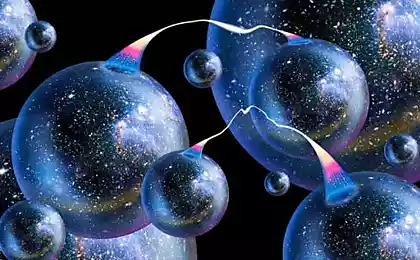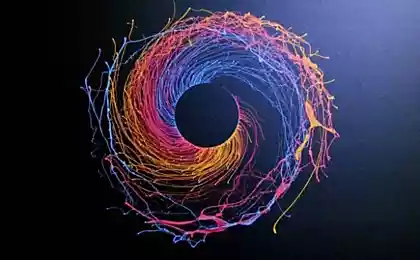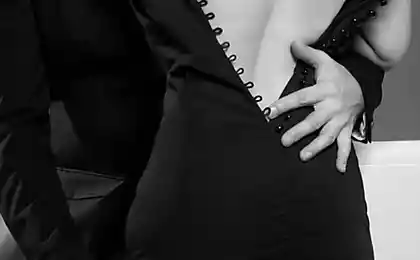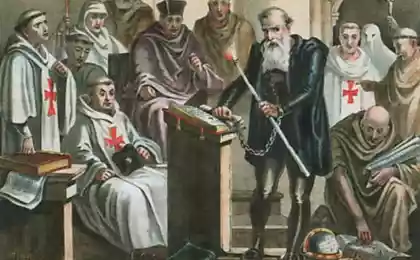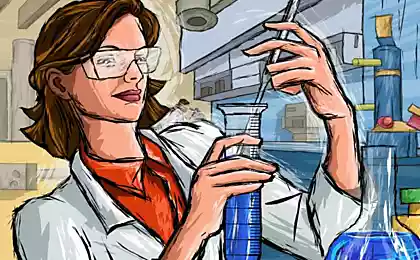978
The neurophysiological aspect of the theory of complexes
Seventy six million seven hundred seventy eight thousand one hundred forty five
I work for a neurologist for over 35 years for 28 of them worked in departmental medical institution, which carried out a continuous medical monitoring and treatment only employees of the Agency and members of their families. In the process of observation and treatment, my attention was attracted by two things.
First: despite my best efforts, the same patients needed treatment 1-2 times a year about the same chronic disease.
And second: I discovered the connection between disease and stress.
I'm sure that if I worked in a usual municipal hospital, it would be difficult to detect these patterns, as patients had the opportunity to be treated in different hospitals of the city and would be a large scatter of data. Gradually I came to the conclusion that the cause of the disease lies in the human psyche. The quest led me to studying neuroscience and psychology. By this time in our country began available the works of C. G. Jung. Two of Jung's statements at the meeting of the Swiss society of psychology (Zurich, 26 September 1942.) caught my attention: "a Sick body cannot be cured without considering the integrity of its functions", and the phrase became the epigraph to this article. Jung has identified the physiological factor as one pole of "mental space", and the second pole — "pole of the higher mental order" — the field is very complex landmarks that include ethical, aesthetic, religious and other traditional factors, under which it is impossible to draw any physiological basis. Jung believed that our understanding is not given yet to find the bridges that connect to each other visibility palpability of the brain and seemingly immaterial mental images, but he was sure that these bridges exist. Jung assumed that will be a long time until the neurophysiology and pathology of the brain, on the one hand, and the psychology of the unconscious, on the other hand, will be able to connect.
With the development of psychological science in General, there is a need and a theoretical understanding of psychoanalytic practice. This subject has become relevant to neuropsychology — the science that develops the cardinal problem of natural science — the problem of brain of the psyche". Domestic psychologists L. S. Vygotsky (1896-1934) and Alexander Luria (1902-1977) believed that the fundamental psychic reality that must be compared to the work of the brain's higher mental functions (HMF). Principles of the relation of the psyche “and the brain was described by A. R. Luria in the form of the theory of system dynamic localization (brain organization) VPF. To the VPF include logical thinking, memory, voluntary attention, speech, cognitive processes, random movements and actions — that is, features that provide purposeful activities. The main characteristics of the PEF: they are formed in vivo under the influence of social factors, mediated by its psychological structure (mainly using
speech system), arbitrary according to the method of implementation. At the same time Liriomiza that there are other psychic phenomena, another mental reality, which has its own specific features and does not meet the specified characteristics of VPF. This psychic reality belongs to the phenomena which belong to эм0ционально-personal sphere to the States of consciousness. To the emotional-personal sphere include congenital (moosonee or unconscious) and involuntary mental processes and States.
The States of consciousness are complex integrative combination of"world image" and "image of yourself". It should be noted that in the neuropsychology of States of consciousness are considered in the context of higher mental functions (VPF), and not in philosophical terms. These complex mental phenomena (emotional-personal sphere and consciousness) are investigated by modern neuropsychology and General psychology is not enough. Despite a number of publications, theoretical and experimental development of this topic is hampered by the fundamental difficulty of this type of psychic phenomena, and also because of the great difficulties in finding adequate methodological approaches to their study.
Luria outlined the main directions of research and argued that the emotional-personal sphere and the sphere of consciousness has a different brain organization than with cognitive processes, and that their pathology is associated mainly with the front parts of the brain, structures of the right hemisphere and deep mediobasal entities (medial parts of the frontal and temporal lobes at the base of the brain). He believed that "it is necessary to examine the ratio of cortical structures located in the convexital surface of the brain (convex), the deep divisions of the brain stem, and with the more ancient divisions of the cerebral hemispheres, which are located in the medial (middle) regions of the brain, and which, by all accounts, bear a completely different function in the provision of human behavior".
Classical neuropsychology deals mainly with violations of the PEF at the local (organic) brain lesions (tumors, trauma, vascular pathology). However, in studies of the psyche of C. G. Jung and in studies of the emotional-personal sphere A. R. Luria traced some "deep bridges", some common characteristics in relation to the object of research, some physiological basis, which manifests itself in mental disorders. Luria was interested in the emotional-personal sphere, considered as a problem. Resultaty obtained Luria, will help to see at least physiologically factor as one of the poles of "mental space" (Jung) in the context of the relationship "brain and mind".During Association tests Jung found that the result is violated in varying degrees, Autonomous behavior of the psyche.
So Jung opened sensually colored complexes and the phenomenon of assimilation. Jung came to the conclusion that external circumstances release a mental process in which certain content is stored and gives impetus to action. Jung called it the "constellation". If we state that a person has taken a position, based on which we can expect that she will react in a certain way, you believe that this person castelliromani. Constellation is an automatic process, it is impossible to stop on their own. According to Jung, castelliromani content represent certain complexes, which have their own specific energy. What happens during the associative test, always happens during the dialogue. Conselleria complexes can destroy the intention of speaking, can put in their mouth answers that they can't remember. This fact is used in the practice of cross-examination“ of witnesses.
Its equivalent in psychology is experiment retry, which detects and localizes failures in memory. Failures or falsifications of memory appear with reasonable regularity in all the spheres of Association, disturbed by the complexes. Jung believed that each constellation of the complexes causes a violation of the unity of consciousness and impedes volitional orientation. Jung identified "sensory-painted complex" as the image of a certain psychic situation which is strongly accentuated emotionally and is, moreover incompatible with the habitual position of awareness.
According to Jung, this image has a powerful internal consistency, and inherent integrity and relatively high level of autonomy, and therefore subject only to limited control of conscious thought, M behaves like an animated foreign body in the sphere of consciousness. The complex is able to assimilate even the ego, M. then there is an instant change in the personality known as identification with the complex — in cases of "obsession". Studying the theory of complexes Jung, I noticed that noting the negative impact of the complex on consciousness and will, at the same time, Jung was inclined to the view that Autonomous complexes are normal life, and that Autonomous systems make up the structure of the unconscious psyche. The complexes are objects of inner experience. Jung considered the creative process as a manifestation of the activities of the Autonomous complex. In itself, the presence of Autonomous complexes is not pathological, only when the manifestations of the complex are frequent and alarming, that it is a symptom of the disease. A. R. Luria before meeting with L. S. Vygotsky (in 1924) was engaged in experimental study of the "emotional conflicts" — hidden emotional complexes, which was associated with his interest in psychoanalysis. A. R. Luria investigated the emotional-personal sphere through the study of speech and motor reactions. He developed the "coupled motor technique" as a variant of the associative techniques, when the subject of the word stimuli should meet speech and motor reactions. Using this technique it was possible to activate hidden emotional complexes.
An indicator of these hidden emotional complexes have been mainly movements of the left hand. This is fully consistent with modern concepts ovedose role of the right hemisphere in the processing of emotional information.
Studies have shown that the hidden emotional States, or "affective complexes" represent a complex system of education, which includes different, interrelated, components (verbal, motor, autonomic). Luria investigated natural and artificial (created under the
hypnosis) "affective complexes" in healthy subjects (students in situations of exams, in individuals suspected of crimes) and patients with neurotic disorders.
The results of the study were published in the monograph "the Nature of human conflicts" (The Nature of Human Conflicts, 1932 r.). Way of learning "affective traces of" crime proposed by Luria, more accurately objectivesare emotional state than the parameters that are used in modern lie detectors. To approach the discussion of the physiological factor as one of the poles of "mental space" (Jung), it is necessary to know what constitutes the brain as a substrate of mental processes, what are the main principles of his device and work. The activity of the body is carried out by the integrating role of the Central and peripheral parts of the nervous system. Psychologists distinguish four levels of integrative activity of the brain.
Each of the four levels contributes to the provision of integrative processes. The first level neuron (a nerve cell with appendages). The second level neuronal microassembly (module), which has qualitatively new properties in comparison with an individual neuron (emergence).
The third level is the nerve center. Nerve center — a set of neural microassembly with multiple direct and feedback to the Central nervous system and peripheral organs. The nerve center as the macrosystem, often acts as a stand-alone command a device that controls a particular process in the body.
The fourth level is the highest between all the centers of the regulation in a single regulatory system, and individual organs M system into a single physiological system — the body. The fourth level of integration provides the interaction of the main systems of the Central nervous system (CNS): the limbic system, reticular formation, subcortical structures and the neocortex (new cortex) — as the highest division of the CNS, and organizes behavioral responses and autonomic security. Thus, the brain is a complex meta-system consisting of various macro-systems (projection, associative, integrative-launcher, the limbic-reticular), each of which is constructed from different Microsystems (microassembly). Integrative activity systems at different levels is provided by their hierarchical dependency, and horizontal-horizontal and vertical-horizontal relationships. An integrative role of the CNS is the subordination and pooling of tissues and organs in the Central-peripheral system, the activity of which is aimed at achieving the useful result of adaptive organism, in accordance with the dominant currently need, and motivation. Dominant as a working principle of nervous centers was opened by A. A. Ukhtomsky (1875-1942). Ukhtomsky was characterized by a dominant feature in the full development of the complex
certain symptoms throughout the body. The dominant feature is opredelennosti centers with increased excitability in different levels of brain and spinal cord, as well as in Autonomous (vegetative) nervous system. The dominant takes on the value of the dominant factor in the work of other nerve centers.
The dominant focus of excitation attracts excitement from the most remote sources, but торм03ит the ability of other centres to respond adequately to the incoming pulses thereto. For example, people in creative inspiration can forget about eating and sleeping, because creative dominant priaulet physiological dominant. Dominanta is characterized by inertia, that is, it can be maintained and repeated in all its wholeness, even in the case where the external environment has changed and the old reasons for the reaction disappeared.
The dominant leaves in the nervous system strong-sometimes an indelible mark. According to Ukhtomsky, the soul can live at the same time many potential dominant — traces of former life. They in turn come into the field of sincere work and clear consciousness, live here for a while, summing up, then go back, yielding the field to the other dominants. The trail once experienced dominant, and sometimes the whole experienced dominant, can be triggered again in the spotlight as soon as the resume, at least in part, the irritant, which became for her adequate. When the brain resumes before experienced dominant, can recover the former constellation to such fullness of experience of the specific content of past experience that it may be a hallucination. Ukhtomsky noted that most of the recovery before the experienced dominants only partial, in the form of symbols, which reduces the affective tension in the nervous system.
Ukhtomsky pointed out that of the traces of the past grow dominant and motivations present in order to predetermine the future. If you do not learn in time makings their dominant, they will possess us. Ukhtomsky considered the dominant normal working principle in the implementation of reactions of the organism to the environment. At the same time, he pointed out, and on patologicheskie aspect dominants that have developed under the influence of "mental injury", i.e. under the influence of a broken and failed reactions to the environment, and which continue to influence its current response as a secret and elusive internal enemies. And it is necessary to reveal the hidden dominant, in fact, owning our behavior, to introduce them back into the sphere of consciousness in order to master them, and through them their future behavior. Of course, as a physician M a psychologist, my attention was caught by a hidden dominant, as the "internal enemy" as destructive fakhar leading physiological order in the mess. To build up a picture of how pathological dominant ukhtomskogo as part of the physiological pole of "mental space", refer to the structural-functional model of the brain as a substrate of mental activity (Luria). According to this model, the whole brain can be divided into 3 basic structural and functional unit:
C) energy or block regulation of the level of brain activity (I unit);
6) the block of reception, processing and storage exteroceptive (outgoing external) information (block II);
E) the block of programming, regulation and control over the flow of mental activity (block III).
Every higher mental function (perception, logical thinking, purposeful behavior, consciousness in General) is carried out with the involvement of all three brain units, each unit contributes to its implementation. the unit includes the nonspecific structures of the midbrain, diencephalic departments, the limbic system, mediobasal the parts of the frontal and temporal lobes of the brain.
I block provides a common activation background, which implements all of the mental functions, supports the General tone of the Central nervous system, необх0димый for any mental activity. I block directly connected with the processes of memory (in their modal-nonspecific form), marking, storage and processing ethnomedicinal information.
l block is a direct brain substrate of different motivational and emotional reactions and States.
The limbic structures of the brain (visceral brain) are involved in the regulation of various emotional States and, above all, in the regulation of the relatively basic emotions: fear, pleasure, anger, pain. The limbic structures of the brain also regulate the processes related to the motivations and needs of the body.
I of food; of the brain (the subcortex) perceives and processes the various information about the state of the internal environment of the body, and regulates these States with the help of neurohumoral, biochemical mechanisms. In the reticular formation of the brain stem are M vasomotor respiratory centers (physiological standalone command-device), nuclei of cranial nerves (peripheral part of the analyzer). In the upper part of unit I are higher autonomic centers that control the body's internal environment and regulating the activity of internal organs through the sympathetic M parasympathetic influence.
In fact, I block of the brain is a biological computer that manages the internal environment of the body and provides energy to the human body and its purposeful behaviour.
II block — the block of reception, processing and storage of information coming from the outside. Mame information 0 the internal organs is processed only l block of the brain. Block II includes basic analizatora systems: visual, auditory, and kinesthetic. This unit provides a modality-specific processes, analysis and synthesis of incoming information, a variety of the Gnostic (cognitive) mental activity. II block are primary, secondary and tertiary fields cortex of the brain. Primary cortical fields (the Central parts of the analyzers) perform analysis of the secondary field is the synthesis of incoming information, are responsible for the gnosis — recognition of images and the perception of new information to form new images. In addition, the secondary cortical fields are responsible for automated, tried and tested practices, movements — praxis. With the participation of the tertiary fields of the cortex are complex KINDS of mental activity: symbolic, verbal, intellectual. m block — the block of programming, prediction, regulation and control over the flow of mental activity. This frontal lobe with vertical and
horizontal connections with the structures of the cerebral cortex and subcortical. Frontal lobe. have a powerful connection with the thalamus — subcortical integrative center (thalamo-frontal system). In the frontal lobes located cortical fields that provide voluntary movements and actions.
I every higher mental function (HMF) is carried out with mandatory participation of all three blocks of the brain.
Pathological dominant is a constellation of structures at all levels of the CNS, then includes the structure of all three blocks of the brain. As the hearth bottom-hole excitation in the Central nervous system, pathological dominant is a functional system with its inherent need, emotion, motivation, and goal-oriented, but differs significantly from the functional system which is formed to provide an arbitrary, goal-directed behaviors. With purposeful behavior the person is aware of the need, the emotion goal and represents a program of action. When reaching a useful result and getting positive emotions motivational excitation in the Central nervous system fades away. Functional system that ensured the dominant, remains in nan/mm and, if necessary, can be re-activated consciously.
When they experience frustration of any basic needs and in the absence of the programme of action for the ` obtaining a useful result is generated functional system pathological dominant. Is the fixation on negative emotions, motivational excitation in the CNS is not quenched, and becomes the focus of stagnant excitation in the subcortex — in the I block of the brain, where the structures related to emotions, motivations and long-term memory. Most often this occurs at the time of injury, emotional shock, when a person gets in an unexpected, unpredictable situation. Often pathological dominant is formed as a result of childhood trauma. The child because of the physiological immaturity may not respond adequately to the stressful situation, especially in the preverbal period. Note that the formation of the Image block of the brain — software — ends only to the 12-1Z-year old.
Thus in the Central nervous system is formed of the pathological dominant center, macrosystem, independent of the command device that has the aim to reproduce unreacted emotion and situation again and again, and thereby indicate frustrirovannosti need. The traumatic experience of the past is always present in the present. Constantly activating in long-term memory of traumatic experiences, negative emotion, pathological dominant transmits topinformation for the II block of the brain, embeds it in the processes of analysis and synthesis of incoming information, and hence affect the imaging result.
I'll block of the brain — software — creates a program of purposeful behavior topic-based pathological dominant. In other words, the pathological dominant, significantly affects the implementation of higher mental functions.
For example, if pathological dominant connected with the offense' perception and thinking of the personality occurs through the prism of resentment is unconscious, because usually the person does not plan the emotion of resentment in purposeful activities. Patologicheskaya dominant, as an incomplete Gestalt, prostaivaya from the brain stem (I block) in the right hemisphere of the brain.
The right hemisphere is more e-mbtonline, responsible for visual thinking oversees, mostly negative emotions M gestalte processes information holistically. In a civilized society, rational mind prevails over feelings, the left hemisphere of the brain predominates over the right, the social aspect of personality biological controls, therefore, pathological dominant long time can be suppressed a cerebral cortex according to the law of hierarchy of systems. However, pathological dominant makes disorder in the General semantic structure of consciousness, i.e. the generalized "image of the world" and complete "self-image" that constitute the content of consciousness.
Over time, the pathological dominant functional system is increasing and growing stronger. This is because the nidus of stagnant excitation has inertia, steadfastly retains her excitement and accumulates incoming pulses. Eventually increasing, pathological dominant M involves the structure of the left hemisphere, thereby causing more serious violations of purposeful behavior. Pathological dominant, distorting perception and thinking, can cause many secondary dominants in the cerebral cortex because it violates social functioning
personality. Disrupting tertiary fields in the cortex, pathological dominant interferes with verbal, symbolic, intellectual activity. In the implementation of each VPF involves the whole brain, and every brain area contributes. Emotions as catalysts, involved and vospriyatii, and in the program's execution behavior. When implementing the behavior of subcortical structures in the first place to respond to biologically significant impulses, so pathological dominant through subcortical structures, thalamo-frontal system, in particular, is able to thwart separatewindow activities.
Control of the cerebral cortex is weakened and powerful pathological dominant can cause personality change. For example, a man becomes pathologically touchy. Through a functional system of the pathological dominant under certain circumstances, the complex can suddenly acquire consciousness and then there is the state of "obsession". In addition. pathological dominant may become the basis of resistance in the process of psihoterapii. Obviously, that complex cantaberry Gestalt, acquires all the properties of the pathological dominant. is a functional system, the morphological basis of the "sensory-painted complex" (Jung) and "the affective complex" (Luria), the identity of which is obvious.
In other words, "sensually painted complex", as a psychological system, is based on the physical plane of the functional system of the pathological dominant - hearth static excitation in the CNS.
Pathological dominant as a functional system through the structure of the brain stem "roots" goes into long term memory — the biographical and the memory of mankind, thus through the complex to communicate with the collective unconscious, with archetypes. Pathological dominant, with a fixation on negative emotions, contributes to the activation of the archetype of the shadow in the unconscious.
IF we consider the pathological dominant in its relationship with the body (somatic part of the dominant), it becomes apparent that pathological dominant is the key to the understanding of the physiological aspects of psychosomatic diseases.
As the hearth static excitation in the subcortex, pathological dominant suppresses the activity of the physiological centers of the 1st block of the brain causes a disturbance of autonomic regulation and upsets the biological activity of the computer for managing the internal environment of the body.
If we consider the features of formation of functional systems of the brain depending on the teaching methodology (Acad. N. In.Maslova, N. Davydovskaya), it becomes clear that in terms of the contradiction between the social aspect of the individual and biological (psychological level), between social determinant and biological (physiological level) within the same brain cheloveka through pathological dominant with its neurosis or psychosomatic illness recovered relationship with their feelings, and achieve personal integrity. The ability of the cortex to recover before experienced dominants only partially, in the form of symbols, used in psychotherapy.
Note that in the dyad "physician - patient" in the process of psychotherapy pathological dominant patient can interact with the pathological dominant of the therapist, even if she is in a latent, dormant and therapist awareness. In this event, the process of containerware a therapist, and then there is a need for supervision or B analysis of the therapist to restore the integrity of its perception. B the process of therapy in the field of consciousness first, most likely, are secondary dominants, so long psychotherapeutic process.
If formirovanii therapy, especially in the transpersonal techniques, it is possible to get a complication in the form of seizure of the ego - complex. This happens because the power of the unconscious can strengthen the pathological dominant or activate the hidden dominant. But the variant and fast, "miraculous" recovery from psychosomatic illness, if the sick person will be fond of the creativity. Pathological dominant, "like a black hole" in space, accumulates a huge amount of energy and the law of variation of microassembly that make up the macrosystem, can be quickly transformed into a creative dominant.
The creative breakthrough as the birth of "supernova" and the person goes to another, higher level of functioning. The law of the variability of neural microassembly implemented in bioadequate teaching Methods (Akad. N. In.Maslova "Noospheric education"). The technique uses a biological human need B work and is based on genetically-determined way of perceiving information, when Vegeta involved both hemispheres of the brain. In the learning process have pathological dominant (manifest and latent con-Alexi) gradually and eco-friendly "redesigned" in the creative. In the process of forming a unified functional system of the brain takes place and the psychocorrection.
Jung describes "a sensuously painted" complex as the image of a certain psychic situation.American neuropsychologist K. Pribram came to the conclusion that our holographic mind. In the light of this theory, the image appears as a complex three-dimensional wave structure, the wave packet is a hologram. The theory of the holographic mind finds confirmation in the works of Russian geneticist, academician p. P. gariaev. In the context of this theory developed psychotherapeutic techniques of imaging (holistic thinking, Acad. N. In.Maslova).thus, the idea of a pathological dominant ukhtomskogo and its functioning within the structure-functional model of the brain (Luria) allows you to see the "bridges" between neurophysiology, on the one hand, and psychology, on the other hand, at least at the level of the physiological factor as odnogoiz poles "mental space" (Jung). If we consider the systemic approach as the dominant principle of the brain (Ukhtomsky) M Autonomous complex as the normal phenomenon of life (Jung) in the context of the holographic model of the mind and in the light of the theory of V. I. Vernadsky on the scope of reason — the "noosphere", it is possible to identify "bridges" between neurophysiology and psychology and the second pole "psihicheskogo space" — pole of the higher mental order (Jung).
Author: Davydovskaya N..
Literature:
C. G. Jung, "the theory of complexes", "Schizophrenia". Ed. Populi, Minsk, 1998.
For G. Jung, "Psychotherapy M world", Zurich, September 26, 1942, Ed. Moive, 1997. C6. "Divine child".
AA. Ukhtomsky "Dominant". Peter, 2002.
ED. Chomsky "Neuropsychology", 4 ed. Moscow, 2005.
BM. Smirnov, C. M. Budylin "Physiology of sensory systems and higher nervous activity", Moscow 2004. And
BM. Smirnov, V. N. Yakovlev "Physiology of the Central nervous system", Moscow, 22004
H. Pribram "languages of the brain", M. 1975.\
AP. Luria "Basics of neuropsychology", Moscow, 2004.
N. In`.Maslova "Noospheric education" 2002.
N.. Davydovskaya "Psychological foundations of M medical natural method of teaching." Abstract of the thesis. Moscow-Almaty, 2005.
P. p. gariaev Wave "genetic CODE" — a scientific publication. M. 1997.
P. K. Anokhin, "the Philosophical aspects of the functional system theory" by M. 1978.
V. I. Vernadsky "the biosphere and the noosphere", M., 2004. October 2013. Almaty, Republic Of Kazakhstan
published
P. S. And remember, just changing your mind — together we change the world! ©
Source: vitau.co/
I work for a neurologist for over 35 years for 28 of them worked in departmental medical institution, which carried out a continuous medical monitoring and treatment only employees of the Agency and members of their families. In the process of observation and treatment, my attention was attracted by two things.
First: despite my best efforts, the same patients needed treatment 1-2 times a year about the same chronic disease.
And second: I discovered the connection between disease and stress.
I'm sure that if I worked in a usual municipal hospital, it would be difficult to detect these patterns, as patients had the opportunity to be treated in different hospitals of the city and would be a large scatter of data. Gradually I came to the conclusion that the cause of the disease lies in the human psyche. The quest led me to studying neuroscience and psychology. By this time in our country began available the works of C. G. Jung. Two of Jung's statements at the meeting of the Swiss society of psychology (Zurich, 26 September 1942.) caught my attention: "a Sick body cannot be cured without considering the integrity of its functions", and the phrase became the epigraph to this article. Jung has identified the physiological factor as one pole of "mental space", and the second pole — "pole of the higher mental order" — the field is very complex landmarks that include ethical, aesthetic, religious and other traditional factors, under which it is impossible to draw any physiological basis. Jung believed that our understanding is not given yet to find the bridges that connect to each other visibility palpability of the brain and seemingly immaterial mental images, but he was sure that these bridges exist. Jung assumed that will be a long time until the neurophysiology and pathology of the brain, on the one hand, and the psychology of the unconscious, on the other hand, will be able to connect.
With the development of psychological science in General, there is a need and a theoretical understanding of psychoanalytic practice. This subject has become relevant to neuropsychology — the science that develops the cardinal problem of natural science — the problem of brain of the psyche". Domestic psychologists L. S. Vygotsky (1896-1934) and Alexander Luria (1902-1977) believed that the fundamental psychic reality that must be compared to the work of the brain's higher mental functions (HMF). Principles of the relation of the psyche “and the brain was described by A. R. Luria in the form of the theory of system dynamic localization (brain organization) VPF. To the VPF include logical thinking, memory, voluntary attention, speech, cognitive processes, random movements and actions — that is, features that provide purposeful activities. The main characteristics of the PEF: they are formed in vivo under the influence of social factors, mediated by its psychological structure (mainly using
speech system), arbitrary according to the method of implementation. At the same time Liriomiza that there are other psychic phenomena, another mental reality, which has its own specific features and does not meet the specified characteristics of VPF. This psychic reality belongs to the phenomena which belong to эм0ционально-personal sphere to the States of consciousness. To the emotional-personal sphere include congenital (moosonee or unconscious) and involuntary mental processes and States.
The States of consciousness are complex integrative combination of"world image" and "image of yourself". It should be noted that in the neuropsychology of States of consciousness are considered in the context of higher mental functions (VPF), and not in philosophical terms. These complex mental phenomena (emotional-personal sphere and consciousness) are investigated by modern neuropsychology and General psychology is not enough. Despite a number of publications, theoretical and experimental development of this topic is hampered by the fundamental difficulty of this type of psychic phenomena, and also because of the great difficulties in finding adequate methodological approaches to their study.
Luria outlined the main directions of research and argued that the emotional-personal sphere and the sphere of consciousness has a different brain organization than with cognitive processes, and that their pathology is associated mainly with the front parts of the brain, structures of the right hemisphere and deep mediobasal entities (medial parts of the frontal and temporal lobes at the base of the brain). He believed that "it is necessary to examine the ratio of cortical structures located in the convexital surface of the brain (convex), the deep divisions of the brain stem, and with the more ancient divisions of the cerebral hemispheres, which are located in the medial (middle) regions of the brain, and which, by all accounts, bear a completely different function in the provision of human behavior".
Classical neuropsychology deals mainly with violations of the PEF at the local (organic) brain lesions (tumors, trauma, vascular pathology). However, in studies of the psyche of C. G. Jung and in studies of the emotional-personal sphere A. R. Luria traced some "deep bridges", some common characteristics in relation to the object of research, some physiological basis, which manifests itself in mental disorders. Luria was interested in the emotional-personal sphere, considered as a problem. Resultaty obtained Luria, will help to see at least physiologically factor as one of the poles of "mental space" (Jung) in the context of the relationship "brain and mind".During Association tests Jung found that the result is violated in varying degrees, Autonomous behavior of the psyche.
So Jung opened sensually colored complexes and the phenomenon of assimilation. Jung came to the conclusion that external circumstances release a mental process in which certain content is stored and gives impetus to action. Jung called it the "constellation". If we state that a person has taken a position, based on which we can expect that she will react in a certain way, you believe that this person castelliromani. Constellation is an automatic process, it is impossible to stop on their own. According to Jung, castelliromani content represent certain complexes, which have their own specific energy. What happens during the associative test, always happens during the dialogue. Conselleria complexes can destroy the intention of speaking, can put in their mouth answers that they can't remember. This fact is used in the practice of cross-examination“ of witnesses.
Its equivalent in psychology is experiment retry, which detects and localizes failures in memory. Failures or falsifications of memory appear with reasonable regularity in all the spheres of Association, disturbed by the complexes. Jung believed that each constellation of the complexes causes a violation of the unity of consciousness and impedes volitional orientation. Jung identified "sensory-painted complex" as the image of a certain psychic situation which is strongly accentuated emotionally and is, moreover incompatible with the habitual position of awareness.
According to Jung, this image has a powerful internal consistency, and inherent integrity and relatively high level of autonomy, and therefore subject only to limited control of conscious thought, M behaves like an animated foreign body in the sphere of consciousness. The complex is able to assimilate even the ego, M. then there is an instant change in the personality known as identification with the complex — in cases of "obsession". Studying the theory of complexes Jung, I noticed that noting the negative impact of the complex on consciousness and will, at the same time, Jung was inclined to the view that Autonomous complexes are normal life, and that Autonomous systems make up the structure of the unconscious psyche. The complexes are objects of inner experience. Jung considered the creative process as a manifestation of the activities of the Autonomous complex. In itself, the presence of Autonomous complexes is not pathological, only when the manifestations of the complex are frequent and alarming, that it is a symptom of the disease. A. R. Luria before meeting with L. S. Vygotsky (in 1924) was engaged in experimental study of the "emotional conflicts" — hidden emotional complexes, which was associated with his interest in psychoanalysis. A. R. Luria investigated the emotional-personal sphere through the study of speech and motor reactions. He developed the "coupled motor technique" as a variant of the associative techniques, when the subject of the word stimuli should meet speech and motor reactions. Using this technique it was possible to activate hidden emotional complexes.
An indicator of these hidden emotional complexes have been mainly movements of the left hand. This is fully consistent with modern concepts ovedose role of the right hemisphere in the processing of emotional information.
Studies have shown that the hidden emotional States, or "affective complexes" represent a complex system of education, which includes different, interrelated, components (verbal, motor, autonomic). Luria investigated natural and artificial (created under the
hypnosis) "affective complexes" in healthy subjects (students in situations of exams, in individuals suspected of crimes) and patients with neurotic disorders.
The results of the study were published in the monograph "the Nature of human conflicts" (The Nature of Human Conflicts, 1932 r.). Way of learning "affective traces of" crime proposed by Luria, more accurately objectivesare emotional state than the parameters that are used in modern lie detectors. To approach the discussion of the physiological factor as one of the poles of "mental space" (Jung), it is necessary to know what constitutes the brain as a substrate of mental processes, what are the main principles of his device and work. The activity of the body is carried out by the integrating role of the Central and peripheral parts of the nervous system. Psychologists distinguish four levels of integrative activity of the brain.
Each of the four levels contributes to the provision of integrative processes. The first level neuron (a nerve cell with appendages). The second level neuronal microassembly (module), which has qualitatively new properties in comparison with an individual neuron (emergence).
The third level is the nerve center. Nerve center — a set of neural microassembly with multiple direct and feedback to the Central nervous system and peripheral organs. The nerve center as the macrosystem, often acts as a stand-alone command a device that controls a particular process in the body.
The fourth level is the highest between all the centers of the regulation in a single regulatory system, and individual organs M system into a single physiological system — the body. The fourth level of integration provides the interaction of the main systems of the Central nervous system (CNS): the limbic system, reticular formation, subcortical structures and the neocortex (new cortex) — as the highest division of the CNS, and organizes behavioral responses and autonomic security. Thus, the brain is a complex meta-system consisting of various macro-systems (projection, associative, integrative-launcher, the limbic-reticular), each of which is constructed from different Microsystems (microassembly). Integrative activity systems at different levels is provided by their hierarchical dependency, and horizontal-horizontal and vertical-horizontal relationships. An integrative role of the CNS is the subordination and pooling of tissues and organs in the Central-peripheral system, the activity of which is aimed at achieving the useful result of adaptive organism, in accordance with the dominant currently need, and motivation. Dominant as a working principle of nervous centers was opened by A. A. Ukhtomsky (1875-1942). Ukhtomsky was characterized by a dominant feature in the full development of the complex
certain symptoms throughout the body. The dominant feature is opredelennosti centers with increased excitability in different levels of brain and spinal cord, as well as in Autonomous (vegetative) nervous system. The dominant takes on the value of the dominant factor in the work of other nerve centers.
The dominant focus of excitation attracts excitement from the most remote sources, but торм03ит the ability of other centres to respond adequately to the incoming pulses thereto. For example, people in creative inspiration can forget about eating and sleeping, because creative dominant priaulet physiological dominant. Dominanta is characterized by inertia, that is, it can be maintained and repeated in all its wholeness, even in the case where the external environment has changed and the old reasons for the reaction disappeared.
The dominant leaves in the nervous system strong-sometimes an indelible mark. According to Ukhtomsky, the soul can live at the same time many potential dominant — traces of former life. They in turn come into the field of sincere work and clear consciousness, live here for a while, summing up, then go back, yielding the field to the other dominants. The trail once experienced dominant, and sometimes the whole experienced dominant, can be triggered again in the spotlight as soon as the resume, at least in part, the irritant, which became for her adequate. When the brain resumes before experienced dominant, can recover the former constellation to such fullness of experience of the specific content of past experience that it may be a hallucination. Ukhtomsky noted that most of the recovery before the experienced dominants only partial, in the form of symbols, which reduces the affective tension in the nervous system.
Ukhtomsky pointed out that of the traces of the past grow dominant and motivations present in order to predetermine the future. If you do not learn in time makings their dominant, they will possess us. Ukhtomsky considered the dominant normal working principle in the implementation of reactions of the organism to the environment. At the same time, he pointed out, and on patologicheskie aspect dominants that have developed under the influence of "mental injury", i.e. under the influence of a broken and failed reactions to the environment, and which continue to influence its current response as a secret and elusive internal enemies. And it is necessary to reveal the hidden dominant, in fact, owning our behavior, to introduce them back into the sphere of consciousness in order to master them, and through them their future behavior. Of course, as a physician M a psychologist, my attention was caught by a hidden dominant, as the "internal enemy" as destructive fakhar leading physiological order in the mess. To build up a picture of how pathological dominant ukhtomskogo as part of the physiological pole of "mental space", refer to the structural-functional model of the brain as a substrate of mental activity (Luria). According to this model, the whole brain can be divided into 3 basic structural and functional unit:
C) energy or block regulation of the level of brain activity (I unit);
6) the block of reception, processing and storage exteroceptive (outgoing external) information (block II);
E) the block of programming, regulation and control over the flow of mental activity (block III).
Every higher mental function (perception, logical thinking, purposeful behavior, consciousness in General) is carried out with the involvement of all three brain units, each unit contributes to its implementation. the unit includes the nonspecific structures of the midbrain, diencephalic departments, the limbic system, mediobasal the parts of the frontal and temporal lobes of the brain.
I block provides a common activation background, which implements all of the mental functions, supports the General tone of the Central nervous system, необх0димый for any mental activity. I block directly connected with the processes of memory (in their modal-nonspecific form), marking, storage and processing ethnomedicinal information.
l block is a direct brain substrate of different motivational and emotional reactions and States.
The limbic structures of the brain (visceral brain) are involved in the regulation of various emotional States and, above all, in the regulation of the relatively basic emotions: fear, pleasure, anger, pain. The limbic structures of the brain also regulate the processes related to the motivations and needs of the body.
I of food; of the brain (the subcortex) perceives and processes the various information about the state of the internal environment of the body, and regulates these States with the help of neurohumoral, biochemical mechanisms. In the reticular formation of the brain stem are M vasomotor respiratory centers (physiological standalone command-device), nuclei of cranial nerves (peripheral part of the analyzer). In the upper part of unit I are higher autonomic centers that control the body's internal environment and regulating the activity of internal organs through the sympathetic M parasympathetic influence.
In fact, I block of the brain is a biological computer that manages the internal environment of the body and provides energy to the human body and its purposeful behaviour.
II block — the block of reception, processing and storage of information coming from the outside. Mame information 0 the internal organs is processed only l block of the brain. Block II includes basic analizatora systems: visual, auditory, and kinesthetic. This unit provides a modality-specific processes, analysis and synthesis of incoming information, a variety of the Gnostic (cognitive) mental activity. II block are primary, secondary and tertiary fields cortex of the brain. Primary cortical fields (the Central parts of the analyzers) perform analysis of the secondary field is the synthesis of incoming information, are responsible for the gnosis — recognition of images and the perception of new information to form new images. In addition, the secondary cortical fields are responsible for automated, tried and tested practices, movements — praxis. With the participation of the tertiary fields of the cortex are complex KINDS of mental activity: symbolic, verbal, intellectual. m block — the block of programming, prediction, regulation and control over the flow of mental activity. This frontal lobe with vertical and
horizontal connections with the structures of the cerebral cortex and subcortical. Frontal lobe. have a powerful connection with the thalamus — subcortical integrative center (thalamo-frontal system). In the frontal lobes located cortical fields that provide voluntary movements and actions.
I every higher mental function (HMF) is carried out with mandatory participation of all three blocks of the brain.
Pathological dominant is a constellation of structures at all levels of the CNS, then includes the structure of all three blocks of the brain. As the hearth bottom-hole excitation in the Central nervous system, pathological dominant is a functional system with its inherent need, emotion, motivation, and goal-oriented, but differs significantly from the functional system which is formed to provide an arbitrary, goal-directed behaviors. With purposeful behavior the person is aware of the need, the emotion goal and represents a program of action. When reaching a useful result and getting positive emotions motivational excitation in the Central nervous system fades away. Functional system that ensured the dominant, remains in nan/mm and, if necessary, can be re-activated consciously.
When they experience frustration of any basic needs and in the absence of the programme of action for the ` obtaining a useful result is generated functional system pathological dominant. Is the fixation on negative emotions, motivational excitation in the CNS is not quenched, and becomes the focus of stagnant excitation in the subcortex — in the I block of the brain, where the structures related to emotions, motivations and long-term memory. Most often this occurs at the time of injury, emotional shock, when a person gets in an unexpected, unpredictable situation. Often pathological dominant is formed as a result of childhood trauma. The child because of the physiological immaturity may not respond adequately to the stressful situation, especially in the preverbal period. Note that the formation of the Image block of the brain — software — ends only to the 12-1Z-year old.
Thus in the Central nervous system is formed of the pathological dominant center, macrosystem, independent of the command device that has the aim to reproduce unreacted emotion and situation again and again, and thereby indicate frustrirovannosti need. The traumatic experience of the past is always present in the present. Constantly activating in long-term memory of traumatic experiences, negative emotion, pathological dominant transmits topinformation for the II block of the brain, embeds it in the processes of analysis and synthesis of incoming information, and hence affect the imaging result.
I'll block of the brain — software — creates a program of purposeful behavior topic-based pathological dominant. In other words, the pathological dominant, significantly affects the implementation of higher mental functions.
For example, if pathological dominant connected with the offense' perception and thinking of the personality occurs through the prism of resentment is unconscious, because usually the person does not plan the emotion of resentment in purposeful activities. Patologicheskaya dominant, as an incomplete Gestalt, prostaivaya from the brain stem (I block) in the right hemisphere of the brain.
The right hemisphere is more e-mbtonline, responsible for visual thinking oversees, mostly negative emotions M gestalte processes information holistically. In a civilized society, rational mind prevails over feelings, the left hemisphere of the brain predominates over the right, the social aspect of personality biological controls, therefore, pathological dominant long time can be suppressed a cerebral cortex according to the law of hierarchy of systems. However, pathological dominant makes disorder in the General semantic structure of consciousness, i.e. the generalized "image of the world" and complete "self-image" that constitute the content of consciousness.
Over time, the pathological dominant functional system is increasing and growing stronger. This is because the nidus of stagnant excitation has inertia, steadfastly retains her excitement and accumulates incoming pulses. Eventually increasing, pathological dominant M involves the structure of the left hemisphere, thereby causing more serious violations of purposeful behavior. Pathological dominant, distorting perception and thinking, can cause many secondary dominants in the cerebral cortex because it violates social functioning
personality. Disrupting tertiary fields in the cortex, pathological dominant interferes with verbal, symbolic, intellectual activity. In the implementation of each VPF involves the whole brain, and every brain area contributes. Emotions as catalysts, involved and vospriyatii, and in the program's execution behavior. When implementing the behavior of subcortical structures in the first place to respond to biologically significant impulses, so pathological dominant through subcortical structures, thalamo-frontal system, in particular, is able to thwart separatewindow activities.
Control of the cerebral cortex is weakened and powerful pathological dominant can cause personality change. For example, a man becomes pathologically touchy. Through a functional system of the pathological dominant under certain circumstances, the complex can suddenly acquire consciousness and then there is the state of "obsession". In addition. pathological dominant may become the basis of resistance in the process of psihoterapii. Obviously, that complex cantaberry Gestalt, acquires all the properties of the pathological dominant. is a functional system, the morphological basis of the "sensory-painted complex" (Jung) and "the affective complex" (Luria), the identity of which is obvious.
In other words, "sensually painted complex", as a psychological system, is based on the physical plane of the functional system of the pathological dominant - hearth static excitation in the CNS.
Pathological dominant as a functional system through the structure of the brain stem "roots" goes into long term memory — the biographical and the memory of mankind, thus through the complex to communicate with the collective unconscious, with archetypes. Pathological dominant, with a fixation on negative emotions, contributes to the activation of the archetype of the shadow in the unconscious.
IF we consider the pathological dominant in its relationship with the body (somatic part of the dominant), it becomes apparent that pathological dominant is the key to the understanding of the physiological aspects of psychosomatic diseases.
As the hearth static excitation in the subcortex, pathological dominant suppresses the activity of the physiological centers of the 1st block of the brain causes a disturbance of autonomic regulation and upsets the biological activity of the computer for managing the internal environment of the body.
If we consider the features of formation of functional systems of the brain depending on the teaching methodology (Acad. N. In.Maslova, N. Davydovskaya), it becomes clear that in terms of the contradiction between the social aspect of the individual and biological (psychological level), between social determinant and biological (physiological level) within the same brain cheloveka through pathological dominant with its neurosis or psychosomatic illness recovered relationship with their feelings, and achieve personal integrity. The ability of the cortex to recover before experienced dominants only partially, in the form of symbols, used in psychotherapy.
Note that in the dyad "physician - patient" in the process of psychotherapy pathological dominant patient can interact with the pathological dominant of the therapist, even if she is in a latent, dormant and therapist awareness. In this event, the process of containerware a therapist, and then there is a need for supervision or B analysis of the therapist to restore the integrity of its perception. B the process of therapy in the field of consciousness first, most likely, are secondary dominants, so long psychotherapeutic process.
If formirovanii therapy, especially in the transpersonal techniques, it is possible to get a complication in the form of seizure of the ego - complex. This happens because the power of the unconscious can strengthen the pathological dominant or activate the hidden dominant. But the variant and fast, "miraculous" recovery from psychosomatic illness, if the sick person will be fond of the creativity. Pathological dominant, "like a black hole" in space, accumulates a huge amount of energy and the law of variation of microassembly that make up the macrosystem, can be quickly transformed into a creative dominant.
The creative breakthrough as the birth of "supernova" and the person goes to another, higher level of functioning. The law of the variability of neural microassembly implemented in bioadequate teaching Methods (Akad. N. In.Maslova "Noospheric education"). The technique uses a biological human need B work and is based on genetically-determined way of perceiving information, when Vegeta involved both hemispheres of the brain. In the learning process have pathological dominant (manifest and latent con-Alexi) gradually and eco-friendly "redesigned" in the creative. In the process of forming a unified functional system of the brain takes place and the psychocorrection.
Jung describes "a sensuously painted" complex as the image of a certain psychic situation.American neuropsychologist K. Pribram came to the conclusion that our holographic mind. In the light of this theory, the image appears as a complex three-dimensional wave structure, the wave packet is a hologram. The theory of the holographic mind finds confirmation in the works of Russian geneticist, academician p. P. gariaev. In the context of this theory developed psychotherapeutic techniques of imaging (holistic thinking, Acad. N. In.Maslova).thus, the idea of a pathological dominant ukhtomskogo and its functioning within the structure-functional model of the brain (Luria) allows you to see the "bridges" between neurophysiology, on the one hand, and psychology, on the other hand, at least at the level of the physiological factor as odnogoiz poles "mental space" (Jung). If we consider the systemic approach as the dominant principle of the brain (Ukhtomsky) M Autonomous complex as the normal phenomenon of life (Jung) in the context of the holographic model of the mind and in the light of the theory of V. I. Vernadsky on the scope of reason — the "noosphere", it is possible to identify "bridges" between neurophysiology and psychology and the second pole "psihicheskogo space" — pole of the higher mental order (Jung).
Author: Davydovskaya N..
Literature:
C. G. Jung, "the theory of complexes", "Schizophrenia". Ed. Populi, Minsk, 1998.
For G. Jung, "Psychotherapy M world", Zurich, September 26, 1942, Ed. Moive, 1997. C6. "Divine child".
AA. Ukhtomsky "Dominant". Peter, 2002.
ED. Chomsky "Neuropsychology", 4 ed. Moscow, 2005.
BM. Smirnov, C. M. Budylin "Physiology of sensory systems and higher nervous activity", Moscow 2004. And
BM. Smirnov, V. N. Yakovlev "Physiology of the Central nervous system", Moscow, 22004
H. Pribram "languages of the brain", M. 1975.\
AP. Luria "Basics of neuropsychology", Moscow, 2004.
N. In`.Maslova "Noospheric education" 2002.
N.. Davydovskaya "Psychological foundations of M medical natural method of teaching." Abstract of the thesis. Moscow-Almaty, 2005.
P. p. gariaev Wave "genetic CODE" — a scientific publication. M. 1997.
P. K. Anokhin, "the Philosophical aspects of the functional system theory" by M. 1978.
V. I. Vernadsky "the biosphere and the noosphere", M., 2004. October 2013. Almaty, Republic Of Kazakhstan
published
P. S. And remember, just changing your mind — together we change the world! ©
Source: vitau.co/



